Like a child that outgrows the old clothes, lizards have to shed their old skin to allow their bodies to grow.
Most lizards have their skin fall off in chunks or flakes for several days. However, the leo shedding process is similar to that of a snake – they shed the old skin all at once and nearly in one piece like they are taking off a worn-out suit.
Although shedding is a low-intensity event for experienced hobbyists, it can cause quite a lot of excitement, worry, and anxiety in a novice leo enthusiast. Also, although it is a pretty straightforward process, sometimes problems can occur along the way.
That is why it is worth knowing what to expect when it’s shedding time.
Let’s dig into the hows and whys of leopard gecko shedding!
How Do I Know If My Leo Is Shedding?
There is one tell-tale visual sign of upcoming shedding – your leo will change color. As the date approaches, his coloration will become duller, and he will eventually turn grayish-white. That happens because the old skin is gradually separating from the body.
Note that the phenomenon is not equally visible in all morphs. In Blizzards and many other albinos, the change is subtle. On the other hand, with wild-type and melanistic leos, the color change can be quite dramatic – from dark brown to grayish-white.
Shedding behavior
Besides the look, your leo’s behavior might also change.
Leos require humidity and moisture for a successful shed, so your pet might spend additional time in his moist hide (or more time hiding in general). He may also lack an appetite for up to a week before shedding.
When the time is due, your leo may start rubbing off of rocks to initiate the shedding. The skin on the head will flake and come off first. During the process, leopard geckos will sway their body, and pull and tug at the old skin using their mouth. I find it especially amusing when they pull off the skin from their front legs, looking like they are taking off a pair of long, posh gloves.
How Often Do Leopard Geckos Shed?
Leopard gecko’s shedding frequency depends on their growth rate.
Young leos who grow vigorously can shed weekly or bi-weekly – definitely more often than older individuals. Mature geckos will shed once a month on average, although there can be longer pauses between sheds.
Is There A Shedding Season For Leopard Geckos?
Generally, there is no season for shedding. However, an adult leo will rarely shed while brumating. Likewise, all the resources in gravid leopard gecko females go towards their eggs, so shedding at this time is also unlikely.
How Long Does Leopard Gecko Shedding Take?
From the moment you notice the dull coloration of your pet, it will be 1-3 days before the shed is complete.
Once the process takes off, it can be mere 10 minutes before it’s over. Still, in some individuals, it can take up to a day to complete.
Can You Hold a Leopard Gecko When It’s Shedding?
Leopard geckos can be cranky while shedding and some may even turn aggressive. Unnecessary handling and stressing out an already stressed gecko can lead to issues like stuck sheds.
Simply provide your leo with the best possible conditions and let nature take its course.
Should I Feed My Leo During The Shedding?
Some leos will eat normally before and after the shedding, but others will avoid food for several days before, and 1-2 days after the completion of the process.
You can offer food as usual – just don’t insist.
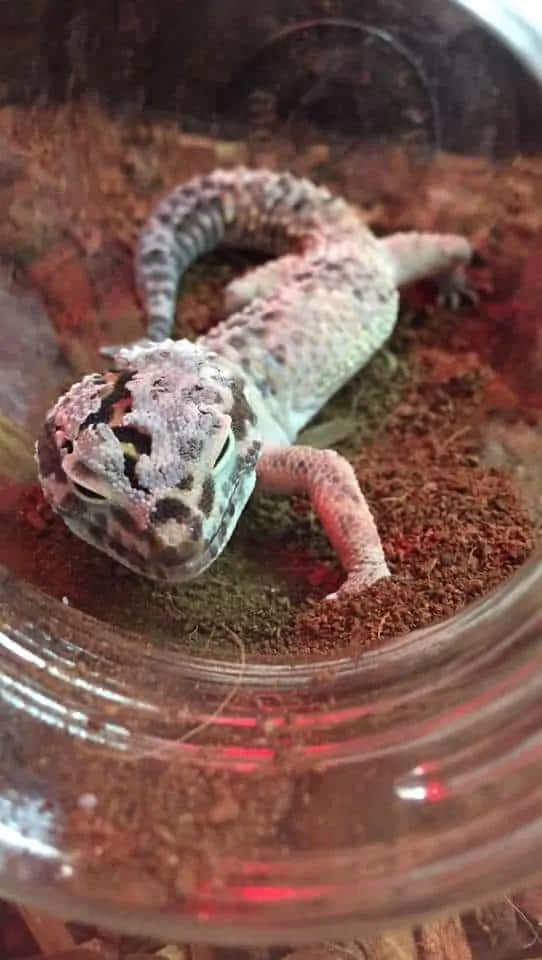
Shedding Problems
Stuck Shed
Stuck sheds are the most common and pretty much the only problem with leopard gecko shedding. Basically, “stuck shed” is a piece of skin that won’t come off. Potential causes include:
- Lack of moisture and moist hide;
- Vitamin deficiency;
- Illness or stress;
- Bad conditions (e.g., temps too low).
However, not all cases can be attributed to these causes; some healthy leos are simply poor shedders, with no apparent reason.
Over time, the stuck skin will become dry and hard, leading to different problems depending on its location on the body.
The most common body parts where stuck sheds occur are the toes. Accumulation and hardening of these skin “rings” can lead to blood being cut off from a toe, damaging the tissue. If the situation lasts, your leo could lose a toe, or get a nasty infection.
Stuck Shed Around The Eyes
Stuck shed around the eyes is about the worst thing that can happen with stuck sheds. Usually, the affected gecko will not be able to open his eyes and the old skin will be visible all around the eyelids.
Leopard Gecko Shedding Too Often
The main reason for shedding is growth. A young leo in the intensive growing phase will shed much more often than an adult. The shedding will continue throughout leo’s lifetime – it will just become a rarer event.
Leopard Gecko Not Shedding
As your leo ages, he or she will shed less often. There isn’t a strict rhythm to this change. Older leos might also enter a growth sprout of a sort, and shed a bit more frequently than usual. But just as well, they could stop shedding for a long period of time.
If you have a young leo that is not shedding, it could be a sign of stunted growth. Create a chart that will help you track down your leo’s length and/or weight, as well as dates of shedding.
How to Handle Stuck Sheds in Leos?
- For toes, give your leo a warm soaking bath (water can merely cover his feet, no need for it to be deeper) lasting for 15-30 minutes. Then, while carefully handling him, pull at the now-softened skin with a pair of tweezers, ideally the quality medical kind. Gently brushing with a Q-tip usually doesn’t work for toes, but you can try if the amount of skin is minimal.
- For sheds stuck around the eyes and other parts of the body, create a “sauna” – put a towel soaked (but not dripping) with warm water in a clean plastic container, with a lid and some air holes. Leave the gecko in there for about 30 minutes. When you get him out, try removing the leftover skin with a moist Q-tip.
Using Oil
In general, I do not advise using oil as the first line of treatment in the case of stuck sheds.
You will often read the advice to use olive or coconut oil on stuck sheds. However, the trouble is that if you fail to remove the shed by oiling, the situation might become even more complicated once that stubborn piece of skin is greasy and sticky. Other parts of the body are easier to treat this way, but the eyes are sensitive and vulnerable.
If you can’t remove the skin around leos eyes after a “gecko sauna” treatment, take him to a reptile vet, who will have the right instruments and experience to deal with the alignment properly. The eye infections in reptiles can get really bad, and personally, I would not take any chances.
If you have no options but to try oil, you can lightly coat the old skin with the help of a Q-tip. You will also use a Q-tip to gently rub and try to get the skin off.
Tips: How to Help a Leopard Gecko Shed
The best way to help your leo shed is to ensure:
- That his food is supplemented with all essential vitamins;
- That his moist hide is clean and moist enough;
- That he has a rough (but not sharp or abrasive) piece of decoration that he can rub against.
When you notice that the old skin has started to come off, do not interfere with the process. In the great majority of cases, a healthy leo will shed without any complications.
Some leo owners like to help their leo with the shed. However, there is a risk that the skin will be peeled off too quickly, resulting in damage to the new skin or parts of the old one getting stuck.
Products That Help Shedding
Baths like Zilla Shed-Ease Reptile Bath and sprays like Zoo Med Repti Snake and Lizard Shedding Aid can help with stuck sheds or prevent shedding issues. They can be used regularly and have other benefits besides helping to shed.
Why Do Leopard Geckos Eat Their Shed?
There are at least three good reasons why leos eat their old skin:
- Shedding the entire skin at once is tiresome work for a little gecko. There is a lot of twisting, turning, and pulling included. Eating the skin is a way to recover at least some energy and nutrients quickly, without having to worry about catching prey.
- In their natural environment, leos have quite a few natural enemies who would gladly turn them into a snack. That is why leos had to evolve strategies to cover their traces, and eating their old skin is one of them.
- As all burrowing and territorial creatures, leos care about cleanliness. That is why they go potty in one corner of the terrarium, and that is why they remove their sheds in the most efficient way possible.
Shedding Box
As I said priorly, moisture is the key to successful shedding. Since with leos we can’t have a humid and moist terrarium environment, we provide them with a moist hide or a shedding box.
Shedding box is usually a plastic box with a moist substrate such as coco coir or peat moss, and an opening just large enough for a leo to get in and out.
Take care!
Have you learned something new about leopard gecko shedding? I hope you found the article to be informative and interesting.
In my opinion, the most valuable takeaway is that shedding is a natural process that shouldn’t be disturbed or helped unless there is an obvious need. Fortunately, if something gets stuck (literally!), there are techniques and products that can save your gecko from pain and discomfort.
What are your experiences with leopard gecko shedding? Do you remember how you felt the first time it had occurred? Feel free to share your story in the comments – we’d love to hear it!
Featured image: Courtesy of Yokohama Anettai Chakan

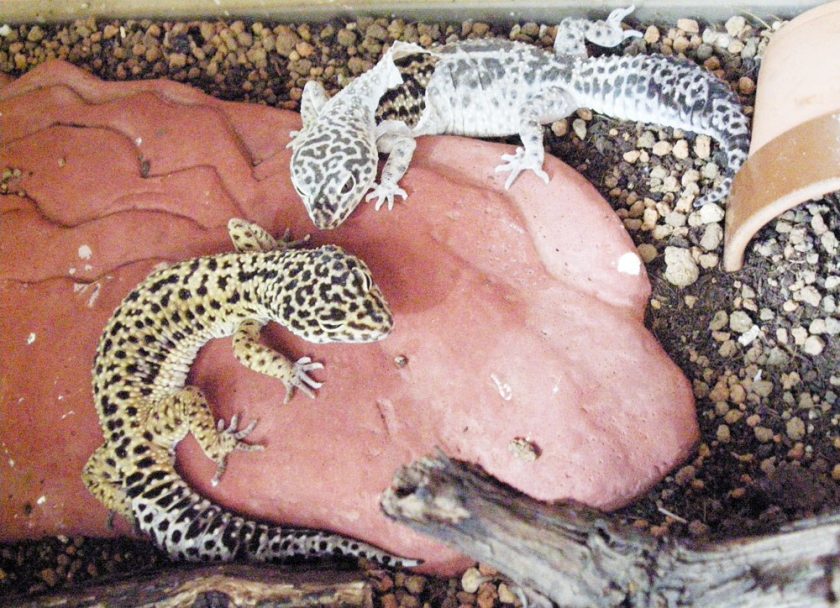
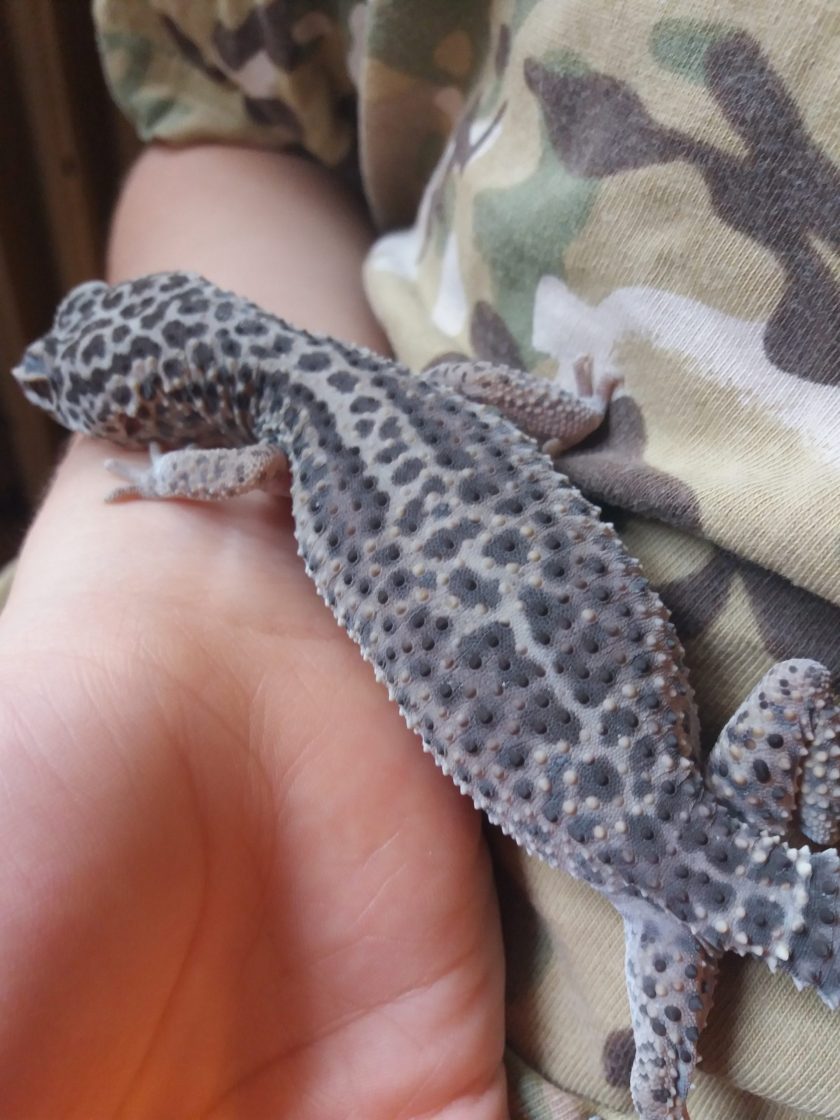
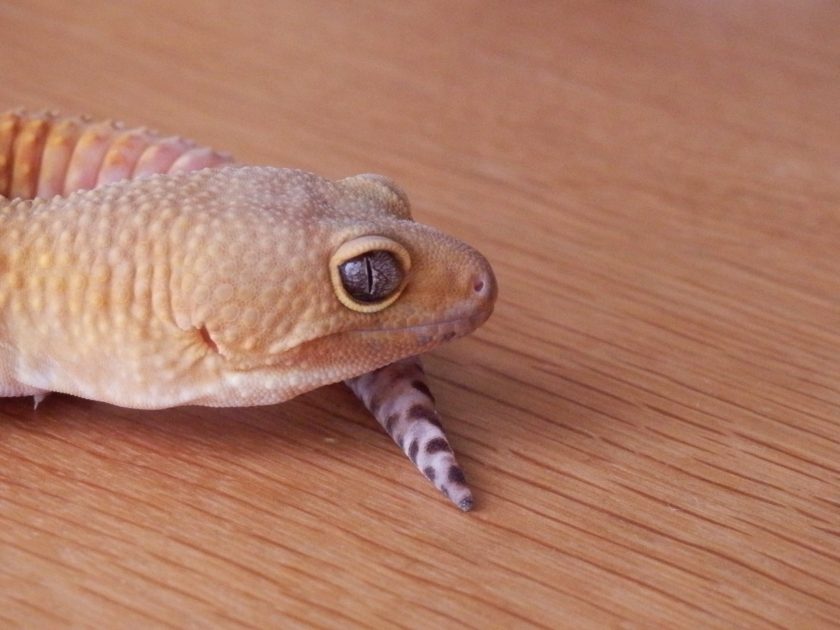
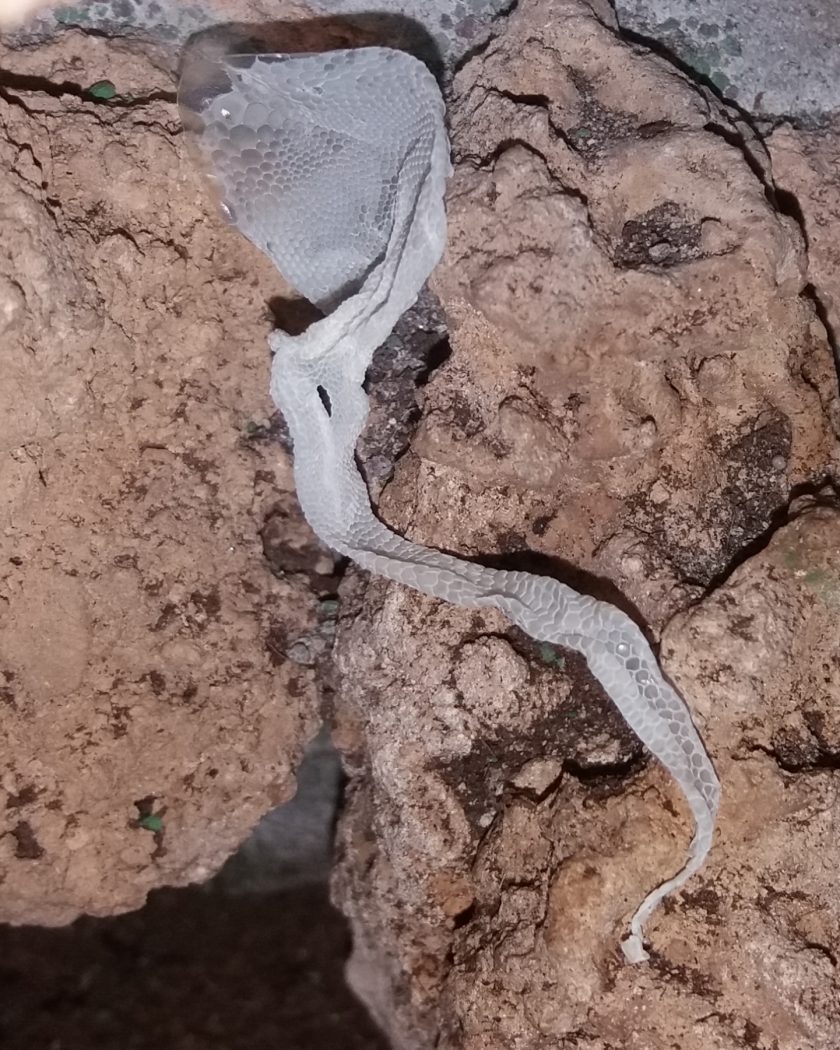

41 Comments
I got my LEO at 3 months old, and, 6 weeks later, he has yet to shed.
His appetite has not slowed down for one second, eats great, all but loaded insects, no lethargy, temps and humidity are spot on, he hasn’t had his colors dull at all, nor, looked brighter as if post-shed, he gets his supplements, UVB 12 hours a day, and spends most of his time in his moist hide, which I most every 1-2 days depending if dried or not.
Temps spot on, humidity spot on, and like I said, he hasnt shown ANY signs of not being healthy
In the 6 weeks I have him, he’s DEFINITELY gotten longer, his tail fuller, and, I hold him 10-15 minutes a night
No idea what could be causing him to have not shed yet.
As mentioned, I hold him nightly, have kept reptiles in past, so, I’d noticed if shedding process began….and nothing.
Please help
Hi Dave,
Your leo seems to be doing great overall, so I wouldn’t worry too much. However, if you notice that he hasn’t been growing much despite eating normally, perhaps have him checked for parasites.
Some leo owners anxious about the growth of their pets like to measure their weight regularly, so there’s an idea.
We have our Leopard Gecko just over a week now and the past day or two he’s been increasingly timid and barely come out of his hides. He has less appetite and has hardly eaten. This morning we noticed he has shed the skin on his head and face shortly after this he vomited. Is this normal or should we be concerned. There’s no shedding evident anywhere else on his body and we hadn’t noticed any prior to this morning. He is an albino so maybe less obvious
Hi Kelly,
I’m sorry you’re having trouble with your leo. I can’t be certain, but your gecko might have suffered from indigestion according to what you’re describing. If that’s the only problem, vomiting prey he couldn’t digest is good, especially if he got better after vomiting.
However, I don’t like the connection with the possibly stuck shed. Leopard geckos should shed in one piece and relatively quickly, and stuck sheds or partial shedding is always a sign of a bigger issue.
Since you got your leo only recently, I suggest taking him to a reptile vet to check for parasites, metabolic bone disease, and vitamin deficiencies. Until then, keep the temperatures in check and if they’re not at the highest, bring them up a bit. Also, make sure that he is supplemented with vitamins and that you offer smaller insects (if he’s eating), or make a gecko slurry (such as golden gate gecko slurry) or buy a product such as Fluker’s Repta+Boost, or Emerald Intensive Care Carnivore. Also, take a look at this article on feeding issues. Hope everything worked out!
Hi. How do you keep the moss moist if the tank is warm and drying it out?
Hey Rachael, You can keep the moss moist by misting it with water daily. If the tank is warm, you can also place a layer of wet paper towels on top of the soil.
Hey everyone! I’m a first time Leo mom and I have some questions… I got my Leo a week ago today and ever since then he hasn’t eaten anything. I tried crickets and meal worms and he just turns his nose up at everything… I’m just worried… he stays in his warm hide all the time…
Hi Jess,
Don’t worry, it’s perfectly normal for a Leo to take a little while to adjust to their new surroundings and get used to their new diet.
It can take as much as two weeks, or even longer in rare cases, for them to start eating regularly again. Just keep offering them a variety of food and eventually they’ll start eating.
Good luck!
Thank you so much for informative information. However I am also a first-time leopard gecko mama. Today is the first time that mine has shed. I’ve noticed that the shedding seems to be stuck on top of his head and over his left eye. It’s got me very worried. Is there anything that I can do? So I know he’ll be okay?
Hi Theresa,
Make sure your geckos moss hide is nice and moist. I would give him a lukewarm bath, make sure he can touch the bottom but damp his head a little. After a 10 minute soak, very gently remove the remaining shed.
Hi! I just got a new juvenile leopard gecko and he’s still not used to me yet and hides in one particular rock hut in particular a lot. I think he’s about to shed but I’m nervous he’ll be too weary to move to the moist hide. Should I make the one he likes to stay in moist or is that too much moisture if he’s going to be in there a lot? Thanks!
Hey K
It’s normal for leopard geckos to pick one particular hiding spot and stay there until they feel comfortable with their surroundings. If your gecko is hiding a lot, it’s probably because it’s still getting used to you and its new environment.
As for shedding, leopard geckos usually do it in their hiding spots. So, if your gecko is hiding in a moist hide, that’s probably fine. Just make sure that the hide isn’t too wet, or your gecko could get skin infections.
Thanks
Hi! Firt time momma here too. I bought a four-year-old leo for about a week ago. He wasn’t handled too much, so I will say he is non-handleabal yet. He shedded his skin on Saturday to Sunday night. On Sunday, I noticed that he had some shed stuck to his hindleg toes, but I decided to let him try to get it of, he did… on one of his legs. I tried to get him to eat on Monday, but he wasn’t hungry. He ate today (Tuesday), but he wouldn’t come that far out if his “safeplace” that i could catch him and give him a “bath”. How long does it take for the stuck shed on his toes to actually hurt him?
Hi Mimi,
Ideally the shed skin shouldn’t stay on there for more than 3-4 days. Does he have a moist hide inside his enclosure?
Thank you so much for putting this out there. It has been very helpful. I am a new Leo momma and I can be a “helicopter mom.” I thought something was wrong when his behavior changed. It is because he started shedding. So I think I was worrying for nothing.
Hi Alisa,
Congratulations on getting your first Leo. Yes, they can change their behaviour during shedding. Please feel free to ask any questions that you may have.
Hey my gecko ate almost all the shed but not the tail is it safe to remove, is it a concern? I just want to make sure my gecko is as healthy as possible.
Hi Corey,
Make sure your geckos moss hide is still nice and moist. Give him another day to get the shed off and if it is still there then give him a luke-warm bath and gently remove the remaining shed.
Hey my gecko ate almost all the shed but not the tail is it safe to remove, is it a concern? I just want to make sure my gecko is as healthy as possible.
This was so helpful I am a first time gecko owner and have been noticed mine has not been eating even though it did at first I also noticed the dull of color today and tonight walked in on mine mid shed I was so worried about these weird behaviors and am now realizing what I can do different next time thank you!
Hi Erin,
I’m glad you enjoyed the article, please feel free to reach out if you have any questions.
How do u give a gecko a bath?
Hi Helena,
Fill a small tub with luke-warm water, place a few drops of repti-safe to condition the water. Make sure the water is not too deep and that the gecko can stand. Place your gecko in the water for 5 minutes, keep a close eye to make sure your gecko is safe.
I can’t see if my leopard gecko is shedding because I don’t see any lose skin but I do find shedding pieces….what do I do and how do I get him Into his moist hide
Hi Ayanna,
Your gecko will usually wander into its moist hide on its own. If there is skin stuck to your gecko then you can give it a bath in some shallow luke-warm water to aid with shedding.
I’ve had my gecko for about two weeks, she’s about 2-3 inches long and looks like she’s going to shed, how can I be sure that she’s shedding and not sick?
Hi Isabella,
Young leopard geckos shed regularly as they are continually growing. Once your geckos skin turns dull it usually takes around 1 – 3 days for the shedding cycle to be complete. If your gecko is still eating and looks to be a good weight then I wouldn’t worry. If your gecko doesn’t shed soon and starts acting as though it is ill then I would suggest visiting a vet.
My Leo is 4. She’s in a full shed, turned solid white from head to tail. It’s been 3 full days like this. She’s spending all her time in her humid hide. I’m concerned because it’s been 3 full days completely white, 5 since starting turning white, but hasn’t begun the shedding process. She usually goes from turning white to being done in less than 36 hours. What do I do if she doesn’t start the shedding process? Thank you for any help.
Hi Anita,
That is a little longer than usual, has she been eating normally? Please double check your temperatures. I would give her one more day and if she has not begun to shed then give her a bath. Put some luke-warm water in a tub with some repti-safe (water conditioner), make sure your gecko can reach the bottom. Soak your gecko for 5 – 10 minutes, if some skin remains stuck you can very gently assist the shed using tweezers.
After my geckos most recent shed, he isn’t active at night but still ate and seems to have the same energy. He’s just been hanging out in his hot hide. Is this normal??
Hi Sara,
What are the temperatures at the hot and cold end of your vivarium. If he’s spending a lot of time in his hot hide, perhaps the rest of the enclosure is too cold? If your temperatures are okay, he’s eating and not losing weight then I wouldn’t worry too much. If he stops eating for an extended period or begins to lose weight, get him looked at by a vet.
Is it normal for them to stop eating their shedding skin ?? If not what should I do ?? I appreciate any advice.. she seems fine but worried that she isn’t eating it anymore. it’s my first time owning one and just want to give her the best care possible.
Hi Melindalee,
It’s nice to see that you really care about your gecko and well done for picking up on changes in her behaviour. Has she completely stopped eating her shed skin or just left some of it? Has she finished shedding or is there still some stuck to her? Is she still eating her crickets or other insects? Things to double check are her moist hide, UV light and temperatures.
So a geko sheds his skin..
My gecko is getting skinny and is shedding but its not coming off his body Im pulled the dead skin off and put calcium on him after soaking him in some calcium water. Hope he gets better
Hi Daniel,
Do you have a moss box inside his enclosure? Is he eating? If he continues to lose weight, take him to see a vet as there could be an underlying issue.
I can’t thank you enough for such informative and easy to read help!
Hi, I am a first time, first gecko mumma… The info on internet is like a mine field..one place contradicts another..however, I have found your site not just informative, easy to understand but an absolute life line for me.. thank you. I have had my little man just over a week now and wow .the worry and stress of am I doing right?, is this wrong? is never ending…now I found you, I hope I can enjoy him alot more…thank you xxxx
Hi Shelley,
Thank you so much for your kind comments. If you have any questions, please don’t hesitate to reach out.
Hi Sam, I have had a rescue giant Leo male gecko for around a month now. Hes still and I don’t think he can shed. Hes in the sauna now as I’m concerned he too (another rescue was the same) has shed issues. This is g his first sauna, and I’m hoping it’ll help him. What if it makes no difference? My other review has terrible shedding issues too. Only 1 of the 3 Leo’s manages without help. They have all their dry calcium, calcium drops and d3 drops as well as a moist hide he won’t use with the moss. I really don’t know what to do as my Gargoyles are fine in their bio setup?
Hi Sandie,
I am sorry your leos are experiencing issues. You’ve mentioned calcium and D3, but what about other vitamins? Are you regularly dusting with multivitamin supplements? Vitamins such as Vitamin A and Vitamin E are essential for proper shedding, but they are usually deficient in feeder insects; that’s why we have to both gutload the insects and dust them with a multivitamin powder. Please read our article on feeding and supplementation for leos, and feel free to check back with us!